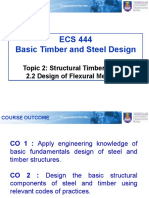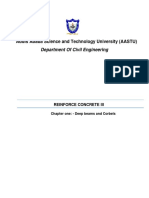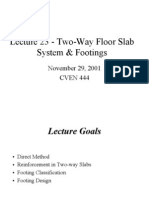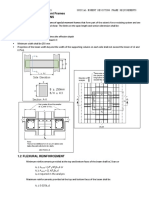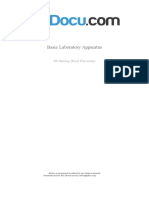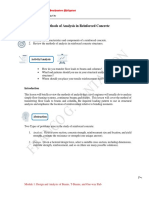0 ratings0% found this document useful (0 votes)
16 viewsPunching Shear
Punching Shear
Uploaded by
rose ann claveriaPunching shear strength is important for determining member thickness, especially near concentrated loads or columns. There are two types of shear failure: beam shear along one axis, and punching shear across two axes. For punching shear, the critical section is located at half the depth from the loaded area. The punching shear strength of an unreinforced slab or footing can be calculated based on the ratio of long to short sides and perimeter of the critical section. For prestressed slabs meeting requirements, punching shear strength considers the average prestress and prestress forces crossing the critical section. Design requires calculated shear strength exceeds the permissible concrete shear stress.
Copyright:
© All Rights Reserved
Available Formats
Download as PPTX, PDF, TXT or read online from Scribd
Punching Shear
Punching Shear
Uploaded by
rose ann claveria0 ratings0% found this document useful (0 votes)
16 views12 pagesPunching shear strength is important for determining member thickness, especially near concentrated loads or columns. There are two types of shear failure: beam shear along one axis, and punching shear across two axes. For punching shear, the critical section is located at half the depth from the loaded area. The punching shear strength of an unreinforced slab or footing can be calculated based on the ratio of long to short sides and perimeter of the critical section. For prestressed slabs meeting requirements, punching shear strength considers the average prestress and prestress forces crossing the critical section. Design requires calculated shear strength exceeds the permissible concrete shear stress.
Original Description:
Pre-stressed
Original Title
1111111111
Copyright
© © All Rights Reserved
Available Formats
PPTX, PDF, TXT or read online from Scribd
Share this document
Did you find this document useful?
Is this content inappropriate?
Punching shear strength is important for determining member thickness, especially near concentrated loads or columns. There are two types of shear failure: beam shear along one axis, and punching shear across two axes. For punching shear, the critical section is located at half the depth from the loaded area. The punching shear strength of an unreinforced slab or footing can be calculated based on the ratio of long to short sides and perimeter of the critical section. For prestressed slabs meeting requirements, punching shear strength considers the average prestress and prestress forces crossing the critical section. Design requires calculated shear strength exceeds the permissible concrete shear stress.
Copyright:
© All Rights Reserved
Available Formats
Download as PPTX, PDF, TXT or read online from Scribd
Download as pptx, pdf, or txt
0 ratings0% found this document useful (0 votes)
16 views12 pagesPunching Shear
Punching Shear
Uploaded by
rose ann claveriaPunching shear strength is important for determining member thickness, especially near concentrated loads or columns. There are two types of shear failure: beam shear along one axis, and punching shear across two axes. For punching shear, the critical section is located at half the depth from the loaded area. The punching shear strength of an unreinforced slab or footing can be calculated based on the ratio of long to short sides and perimeter of the critical section. For prestressed slabs meeting requirements, punching shear strength considers the average prestress and prestress forces crossing the critical section. Design requires calculated shear strength exceeds the permissible concrete shear stress.
Copyright:
© All Rights Reserved
Available Formats
Download as PPTX, PDF, TXT or read online from Scribd
Download as pptx, pdf, or txt
You are on page 1of 12
Punching shear
Strength in shear frequently controls the
thickness of the member, particularly in the
vicinity of a concentrated load or a column.
Beam-type shear (or one-way
shear)
The critical section for this type of shear failure is
usually assumed to be located at a distance d from the
face of the column or concentrated load.
Punching shear (or two-way
shear failure)
The critical section for punching shear is usually taken
to be geometrically similar to the loaded area and
located at a distance d/2 from the face of the loaded
area.
The punching shear strength of a slab or footing not
containing shear reinforcement, Vuc
where βc is the ratio of the long side to the short side of
the loaded area and u is the perimeter
of the critical section.
For a two-way prestressed slab, in which no portion of
the column cross-section is closer to a discontinuous
edge than four times the slab thickness.
where σcp is the average value of effective prestress
(P/A) for each direction and Vp is thevertical
component of all effective prestressing forces crossing
the critical section
Design requirement for a slab containing no shear
reinforcement is that does not exceed a permissible
shear stress υc carried by the concrete. For non-
prestressed slabs.
and for two-way prestressed slabs that meet the
requirements that apply for Equat
You might also like
- 2.2 Design of Flexural MemberDocument26 pages2.2 Design of Flexural MemberNazihah100% (1)
- Chapter 1-Deep Beam & Corbel 2Document37 pagesChapter 1-Deep Beam & Corbel 2Helen Negash100% (4)
- Reinforced Concrete Grade Beams, Piles & Caissons: A Practical Guide for Hillside ConstructionFrom EverandReinforced Concrete Grade Beams, Piles & Caissons: A Practical Guide for Hillside ConstructionNo ratings yet
- The Civil Engineering Professional Licensure Examination - docx-CLAVERIADocument3 pagesThe Civil Engineering Professional Licensure Examination - docx-CLAVERIArose ann claveriaNo ratings yet
- RCI Hand Out Chapter 3Document12 pagesRCI Hand Out Chapter 3Nathnael JiaNo ratings yet
- Chapter 1 - Design of Special BeamsDocument15 pagesChapter 1 - Design of Special BeamsSine EntertaimentNo ratings yet
- 4.4.1 Shear in Flat Plate and Flat Slab Floor Systems: PanelsDocument1 page4.4.1 Shear in Flat Plate and Flat Slab Floor Systems: PanelsBON2LAONo ratings yet
- Limit State of Collapse in ShearDocument21 pagesLimit State of Collapse in ShearNavi RengarajanNo ratings yet
- 2way Slab & FootingDocument52 pages2way Slab & FootingMuhammad Saqib Abrar0% (1)
- 18 Design For ShearDocument13 pages18 Design For Shearkiran sreekumarNo ratings yet
- Ultimate Strength DesignDocument25 pagesUltimate Strength DesignBryle Steven Newton75% (4)
- SOM Ch-6Document9 pagesSOM Ch-6Yash Kumar Kasera KaseraNo ratings yet
- 5-Shear Design of BeamsDocument53 pages5-Shear Design of Beamshamadamjad047No ratings yet
- EC2-Shear and TorsionDocument9 pagesEC2-Shear and TorsionDonald HamiltonNo ratings yet
- 5beams2 PDFDocument84 pages5beams2 PDFAlexa BuquirNo ratings yet
- 2.2 Design of Flexural MembersDocument25 pages2.2 Design of Flexural MembersAin SyahiraNo ratings yet
- Chapter 3 STR 3 Beams Shear BondDocument8 pagesChapter 3 STR 3 Beams Shear BonddaniNo ratings yet
- Madvi Ko Behjna HaiDocument7 pagesMadvi Ko Behjna Haibhavyakumar26No ratings yet
- Design of Rc-Beams For ShearDocument36 pagesDesign of Rc-Beams For ShearAkli Ale ManNo ratings yet
- Design For ShearDocument7 pagesDesign For ShearstarykltNo ratings yet
- Design of Shallow FoundationsDocument25 pagesDesign of Shallow FoundationsZeleke TaimuNo ratings yet
- Corbel DesignDocument13 pagesCorbel DesignAshraf ZayedNo ratings yet
- Two-Way Floor Slab System & FootingsDocument52 pagesTwo-Way Floor Slab System & Footings'Izzad AfifNo ratings yet
- SADSt BeamsDocument27 pagesSADSt BeamsFrank JohnNo ratings yet
- Unit - 4: Design of BeamsDocument27 pagesUnit - 4: Design of BeamsfarhanyazdaniNo ratings yet
- Flexure Members: 7.1 Types of BeamsDocument14 pagesFlexure Members: 7.1 Types of BeamsnabinniraulaNo ratings yet
- Ch6 Transverse ShearDocument33 pagesCh6 Transverse ShearDoğukan KurtuluşNo ratings yet
- Chapter V - 1 - Design of Deep Flexural MemberDocument56 pagesChapter V - 1 - Design of Deep Flexural Memberpemeliharaan pi3No ratings yet
- Document 1728332929Document7 pagesDocument 1728332929dorian.vito821No ratings yet
- Foundation DesignDocument4 pagesFoundation Designram_babu_59No ratings yet
- Compression MembersDocument48 pagesCompression MembersShivang VivekNo ratings yet
- Unit - 6 Design of FootingDocument90 pagesUnit - 6 Design of FootingYash Ashok MankarNo ratings yet
- SymbDocument0 pagesSymbwearplayNo ratings yet
- Flexural Member DesignDocument50 pagesFlexural Member DesignremedanNo ratings yet
- Chapter 4 PDFDocument10 pagesChapter 4 PDFWendimu TolessaNo ratings yet
- DSS Design of Steel BeamsDocument14 pagesDSS Design of Steel Beamsrashmi ashtekarNo ratings yet
- Shear Behaviour of BeamDocument9 pagesShear Behaviour of BeampriyanaNo ratings yet
- Design For Beams: Prepared By: Engr. Jo Ann C. CeledioDocument28 pagesDesign For Beams: Prepared By: Engr. Jo Ann C. CeledioMugiwara SparrowNo ratings yet
- Chapter 2 - Shear Design SP 17-09-07Document37 pagesChapter 2 - Shear Design SP 17-09-07Alex FerrariNo ratings yet
- Footing DesignDocument35 pagesFooting DesignAngel MouriNo ratings yet
- Design of Shear Reinforcement in RCC Structures: Intended Learning Outcomes (ILO)Document16 pagesDesign of Shear Reinforcement in RCC Structures: Intended Learning Outcomes (ILO)anirbanpwd76100% (1)
- Isolated Footing Design Guidelines: Specifications For Design of Footings As Per IS 456: 2000Document6 pagesIsolated Footing Design Guidelines: Specifications For Design of Footings As Per IS 456: 2000Gani AnosaNo ratings yet
- Shear Flow in MembersDocument9 pagesShear Flow in MembersMax NgNo ratings yet
- One Way Slab & Ribbed Slab (1)Document27 pagesOne Way Slab & Ribbed Slab (1)Haymanot MollaNo ratings yet
- Earthquake Resistant Structure SMRF RequirementDocument9 pagesEarthquake Resistant Structure SMRF RequirementMohamed AliNo ratings yet
- Design of Column BasesDocument9 pagesDesign of Column Basesdarshanakp100% (1)
- Lecture 34 - Design of Two-Way Floor Slab System: April 12, 2001 CVEN 444Document22 pagesLecture 34 - Design of Two-Way Floor Slab System: April 12, 2001 CVEN 444Ahmed EwisNo ratings yet
- Lecture Shear2021Document10 pagesLecture Shear2021Akram ShakirNo ratings yet
- FootingDocument29 pagesFootingMozammel hoqueNo ratings yet
- Reinforced Concrete: Assist. ProfDocument16 pagesReinforced Concrete: Assist. ProfMohamed MuayidNo ratings yet
- Shear Design of BeamDocument46 pagesShear Design of BeamNeha ChauhanNo ratings yet
- Cylindrical Compression Helix Springs For Suspension SystemsFrom EverandCylindrical Compression Helix Springs For Suspension SystemsNo ratings yet
- Instructions on Modern American Bridge BuildingFrom EverandInstructions on Modern American Bridge BuildingNo ratings yet
- Some Mooted Questions in Reinforced Concrete Design American Society of Civil Engineers, Transactions, Paper No. 1169, Volume LXX, Dec. 1910From EverandSome Mooted Questions in Reinforced Concrete Design American Society of Civil Engineers, Transactions, Paper No. 1169, Volume LXX, Dec. 1910No ratings yet
- An Introduction to Metal-Working (Illustrated)From EverandAn Introduction to Metal-Working (Illustrated)Rating: 2.5 out of 5 stars2.5/5 (2)
- Polomolok Water District: Demographic ProfileDocument5 pagesPolomolok Water District: Demographic Profilerose ann claveriaNo ratings yet
- CIAP Document 102 (GenConContract)Document55 pagesCIAP Document 102 (GenConContract)Lc Fernandez67% (3)
- Basic Laboratory ApparatusDocument12 pagesBasic Laboratory Apparatusrose ann claveriaNo ratings yet
- PermutationDocument1 pagePermutationrose ann claveriaNo ratings yet
- MATH 116 - Probability and StatisticsDocument1 pageMATH 116 - Probability and Statisticsrose ann claveriaNo ratings yet
- Lifepo4 Battery Quotation SheetDocument5 pagesLifepo4 Battery Quotation Sheetrose ann claveriaNo ratings yet
- Assignment - Combinations April 24, 2020 Solve The Following Problems. Show Your Solutions!Document1 pageAssignment - Combinations April 24, 2020 Solve The Following Problems. Show Your Solutions!rose ann claveriaNo ratings yet
- CMPM Seminar Reflection FormatDocument1 pageCMPM Seminar Reflection Formatrose ann claveriaNo ratings yet
- Objectives:: (At-Rest, Active and Passive Pressures)Document16 pagesObjectives:: (At-Rest, Active and Passive Pressures)rose ann claveriaNo ratings yet
- PD 1594 and Its Implementing Rules and Regulation As AmendedDocument6 pagesPD 1594 and Its Implementing Rules and Regulation As Amendedrose ann claveriaNo ratings yet
- Subsurface Exploration: Sampling/Characterization MethodsDocument13 pagesSubsurface Exploration: Sampling/Characterization Methodsrose ann claveriaNo ratings yet
- Deep Foundation DesignDocument31 pagesDeep Foundation Designrose ann claveriaNo ratings yet
- Questionaire Ce LawsDocument3 pagesQuestionaire Ce Lawsrose ann claveriaNo ratings yet
- GLE/CEE 330: Soil Mechanics Earth Retaining Structures: Geological Engineering University of Wisconsin-MadisonDocument13 pagesGLE/CEE 330: Soil Mechanics Earth Retaining Structures: Geological Engineering University of Wisconsin-Madisonrose ann claveriaNo ratings yet
- University of Southeastern Philippines: For. Whelson C. PasosDocument14 pagesUniversity of Southeastern Philippines: For. Whelson C. Pasosrose ann claveriaNo ratings yet
- Assignment No. 2 Tension MembersDocument1 pageAssignment No. 2 Tension Membersrose ann claveriaNo ratings yet
- Subsurface Exploration: - Sampling/Characterizatio N MethodsDocument34 pagesSubsurface Exploration: - Sampling/Characterizatio N Methodsrose ann claveriaNo ratings yet
- Karen-Cecille 145 Karen-Jayson 60 Cecille-Jayson 105Document2 pagesKaren-Cecille 145 Karen-Jayson 60 Cecille-Jayson 105rose ann claveriaNo ratings yet
- CE Laws MDULE 1.2Document9 pagesCE Laws MDULE 1.2rose ann claveriaNo ratings yet
- CE Laws MDULE 1.1Document6 pagesCE Laws MDULE 1.1rose ann claveriaNo ratings yet
- "Earth Retaining Structures and Excavations" Retaining WallDocument23 pages"Earth Retaining Structures and Excavations" Retaining Wallrose ann claveriaNo ratings yet
- Lesson 3 Analysis & Design of Singly Reinforced Beams PDFDocument18 pagesLesson 3 Analysis & Design of Singly Reinforced Beams PDFrose ann claveriaNo ratings yet
- Lesson 1 Introduction To RC DesignDocument6 pagesLesson 1 Introduction To RC Designrose ann claveriaNo ratings yet
- Lesson 2 Methods of Analysis in RC DesignDocument8 pagesLesson 2 Methods of Analysis in RC Designrose ann claveriaNo ratings yet
- Lesson 4 Analysis & Design of Doubly-Reinforced BeamsDocument12 pagesLesson 4 Analysis & Design of Doubly-Reinforced Beamsrose ann claveriaNo ratings yet
- MATH 116 - Probability and Statistics Home QuizDocument1 pageMATH 116 - Probability and Statistics Home Quizrose ann claveriaNo ratings yet
